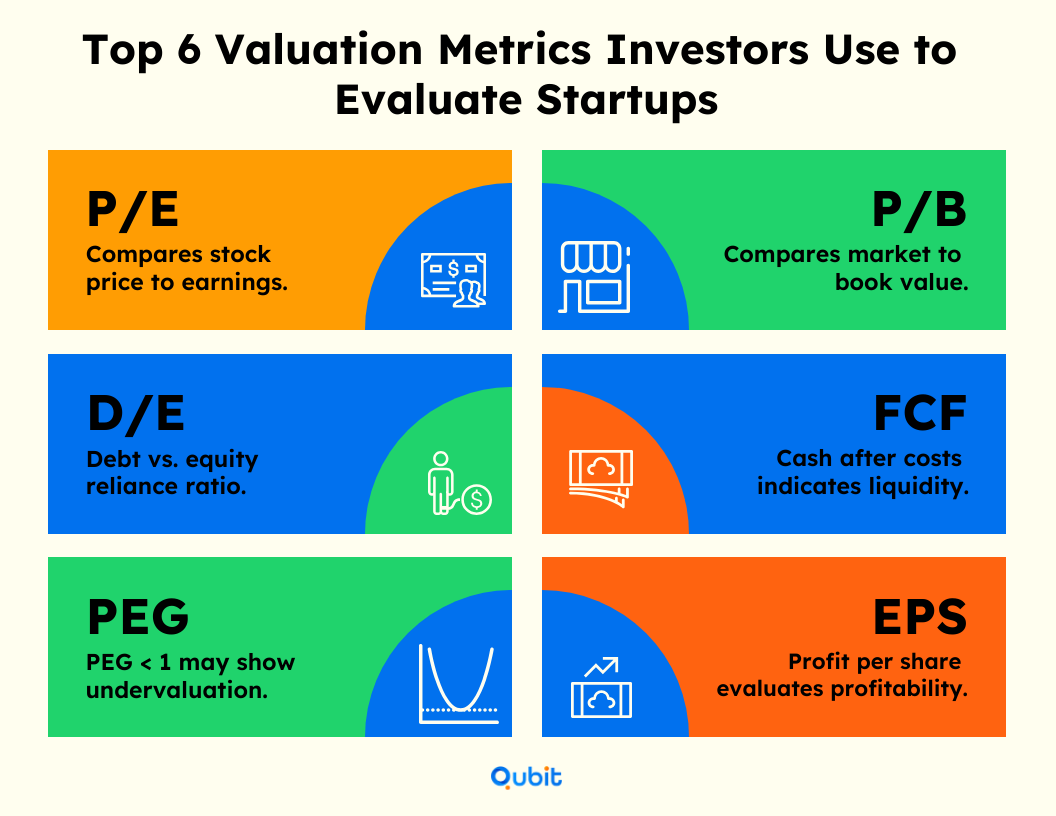Understanding which financial metrics truly resonate with investors can be the difference between securing funding and missing out on opportunities. Investors prioritize data that reveals a company’s financial health, growth potential, and ability to deliver returns. Whether you're exploring how to find undervalued stocks or aiming to refine your pitch, focusing on key metrics is essential.
For businesses seeking investment, knowing how to create a financial model for investors provides a solid foundation for identifying the metrics that matter most. This process ensures your projections align with investor expectations and highlight critical benchmarks.
Let’s dive into it.

1. Price-to-Earnings Ratio
The Price-to-Earnings (P/E) ratio is a cornerstone metric in stock valuation, offering investors a straightforward way to assess whether a stock is undervalued or overvalued. By comparing a company’s market price per share to its earnings per share, the P/E ratio provides a snapshot of how much investors are willing to pay for each dollar of earnings.
This metric is especially valuable when comparing companies within the same industry, as it accounts for sector-specific dynamics that might influence valuation. For example, a company with a lower P/E ratio relative to its peers might indicate an undervalued stock, presenting a potential buying opportunity. However, it’s important to note that the P/E ratio doesn’t factor in future earnings growth, which can be a critical component of long-term investment decisions.
Selecting the best financial forecasting software for startups can streamline the process of tracking critical metrics like the P/E ratio, ensuring that investors have access to accurate and timely data for informed decision-making.
Understanding how to find undervalued stocks using the P/E ratio is a skill that can significantly enhance portfolio performance, but it’s most effective when combined with other investing metrics to create a comprehensive valuation strategy.
2. Price-to-Book Ratio
The Price-to-Book (P/B) ratio is a widely used valuation metric that compares a company’s market value to its book value, offering insights into whether a stock is undervalued or overvalued. A P/B ratio near or below 1 often signals that the market price is close to or less than the company’s net asset value, making it an attractive option for value investors.
Value investors frequently target companies with a P/B ratio below 1 because it suggests that the market may be undervaluing the firm’s tangible assets. This approach allows investors to identify opportunities where the stock price does not fully reflect the company’s intrinsic worth. Exploring advanced financial modeling techniques allows for a deeper understanding of how metrics interact within complex financial models, including the P/B ratio's role in assessing undervaluation.
To maximize the benefits of this metric, investors should also consider contextual analysis, such as learning how to perform scenario analysis in financial modeling, to account for market uncertainties.
3. Debt-to-Equity Ratio
The Debt-to-Equity (D/E) ratio is a vital metric that reveals how a company funds its operations, comparing borrowed capital to shareholder equity. This ratio serves as a snapshot of a company’s financial strategy, highlighting whether it relies more heavily on debt or equity to support its growth. A lower D/E ratio often signifies a conservative approach to financing, minimizing risk by reducing reliance on borrowed funds. Conversely, a higher ratio can indicate aggressive debt usage, which may amplify returns but also increase financial vulnerability.
Industry-specific benchmarks are essential when interpreting D/E ratios. For example, companies in capital-intensive sectors like utilities or manufacturing typically operate with higher D/E ratios due to the nature of their business models. Understanding these benchmarks ensures accurate evaluation and avoids misjudging a company’s financial health.
Using AI financial modeling tools can enhance accuracy and efficiency when evaluating key financial metrics, particularly external factors influencing D/E ratios.
4. Free Cash Flow
Free Cash Flow (FCF) serves as a vital indicator of a company’s financial health, revealing the cash available after operational costs and capital expenditures are covered. This metric not only highlights liquidity but also provides a glimpse into the potential for long-term growth. Investors often monitor FCF trends to identify investment opportunities, as rising FCF can signal future earnings growth and an increase in stock value.
For those focused on value metrics and value investing formulas, understanding FCF is essential. It allows you to assess whether a company has the financial flexibility to reinvest in its business or return value to shareholders through dividends or buybacks. Tracking this metric is a strategic move for evaluating both stability and growth potential in the market.
5. PEG Ratio
Traditional valuation metrics like the Price-to-Earnings (P/E) ratio often provide a snapshot of a stock's current valuation, but they can fall short when assessing future potential. The Price/Earnings-to-Growth (PEG) ratio refines this approach by incorporating expected earnings growth into the equation. This adjustment offers investors a more forward-looking perspective, making it particularly useful for evaluating growth stocks.
A PEG ratio less than one typically signals that a stock may be undervalued relative to its growth potential. This metric can help investors identify opportunities where earnings growth is expected to outpace the current valuation. By combining growth projections with valuation metrics, the PEG ratio provides a more nuanced view of a stock's prospects.
6. Earnings Per Share
Earnings Per Share (EPS) serves as a critical metric for evaluating a company’s profitability on a per-share basis. By dividing the net income by the number of outstanding shares, EPS provides a clear snapshot of how much profit is attributable to each share owned by investors. This makes it an essential tool for assessing financial performance and comparing companies within the same industry.
For investors, understanding EPS is invaluable when making informed decisions. It highlights the efficiency of a company in generating profit relative to its equity structure.
Profitability and Performance Indicators
Profitability metrics show how well a business turns revenue into profit. They provide insights into efficiency and operational strength. Here’s a deeper look at key performance indicators, explained clearly and with examples.
Gross Profit Margin
- What It Is:
This ratio shows the percentage of revenue left after subtracting the cost of goods sold (COGS). - Short Explanation:
It indicates how well a company controls production costs. - Example:
If a company has a 40% gross margin, it keeps 40 cents for every dollar after covering COGS. - Why Investors Care:
Consistent or improving margins suggest strong cost management and operational efficiency.
Operating Margin
- What It Is:
This metric measures profit after deducting operating expenses from revenue. - Short Explanation:
It reflects the efficiency of the company’s core business activities. - Example:
A 15% operating margin means that 15 cents of every dollar earned remains as profit from operations. - Why Investors Care:
It filters out non-operational items and focuses on how well the company manages its day-to-day costs.
Net Profit Margin
- What It Is:
This ratio shows the profit remaining after all expenses, taxes, and costs are deducted. - Short Explanation:
It measures the overall profitability of a company. - Example:
A 10% net profit margin means that for every dollar of revenue, 10 cents is profit. - Why Investors Care:
It gives a clear picture of bottom-line efficiency and is crucial for assessing long-term sustainability.
Earnings Per Share (EPS)
- What It Is:
EPS is calculated by dividing net income by the number of outstanding shares. - Short Explanation:
It provides a per-share measure of profitability. - Example:
If a company earns $100 million in net income and has 50 million shares, its EPS is $2 per share. - Why Investors Care:
EPS enables comparisons between companies and influences stock price decisions. Small changes can have a big impact.
EBITDA Margin
- What It Is:
EBITDA stands for Earnings Before Interest, Taxes, Depreciation, and Amortization. - Short Explanation:
This margin focuses on the company’s operational performance by excluding non-cash and one-time expenses. - Example:
An EBITDA margin of 25% means that 25 cents of every dollar of revenue remains after operating expenses. - Why Investors Care:
It offers a clean view of operational efficiency, making it easier to compare companies across industries.
Integrated Analysis
- Holistic View:
Each metric provides a different angle on performance. - Balanced Analysis:
Using them together gives a complete picture of financial health. - Practical Insight:
Investors can identify strengths, spot potential weaknesses, and understand overall trends. - Actionable Data:
Short, clear figures help in making quick, informed decisions.
These profitability and performance indicators simplify complex financial data. They transform detailed statements into understandable numbers that guide smart, data-driven decisions. Investors rely on these metrics to gauge a company’s current health and future potential.
Conclusion
Understanding key financial metrics is essential for making informed investment decisions. By focusing on valuation metrics and risk indicators, investors can craft a narrative-driven analysis that highlights opportunities and mitigates potential pitfalls. This approach not only ensures clarity but also fosters a deeper understanding of the financial health and growth potential of startups.
Combining valuation and risk metrics creates a robust framework for evaluating investment opportunities. This dual perspective allows investors to balance potential returns against associated risks, ultimately leading to more strategic and confident decisions.
If you're ready to apply these insights to your investment strategy, we invite you to explore our Startup Matchmaking service. At Qubit Capital, we specialize in connecting investors with startups that align with their financial goals and vision. Contact us today to take the next step toward smarter, more impactful investments.
Key Takeaways
- Understanding key financial ratios is essential for evaluating both valuation and risk.
- Metrics such as P/E, P/B, D/E, FCF, PEG, ROI, EPS, Dividend Yield, Operating Margin, ROE, and Beta each offer unique insights.
- A combined approach using these metrics enables a more comprehensive investment analysis.
- Actionable internal and external resources enhance data-driven decision-making.
- Qubit Capital’s expert services empower investors to make informed choices.
Frequently asked Questions
What metrics do investors care about?
Investors evaluate a variety of metrics to gauge a company’s performance and potential. Key indicators include the Price-to-Earnings (P/E) ratio, Return on Investment (ROI), and Free Cash Flow (FCF). These metrics provide insights into valuation, profitability, and financial stability, helping investors assess both opportunities and risks.


 Back
Back



